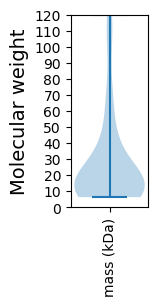
Clostridium phage PhiS63
Taxonomy: Viruses; Duplodnaviria; Heunggongvirae; Uroviricota; Caudoviricetes; Caudovirales; Siphoviridae; unclassified Siphoviridae
Average proteome isoelectric point is 7.03
Get precalculated fractions of proteins

Virtual 2D-PAGE plot for 43 proteins (isoelectric point calculated using IPC2_protein)
Get csv file with sequences according to given criteria:
* You can choose from 21 different methods for calculating isoelectric point
Summary statistics related to proteome-wise predictions



Protein with the lowest isoelectric point:
>tr|I2E8V9|I2E8V9_9CAUD Gp11 OS=Clostridium phage PhiS63 OX=1187894 PE=4 SV=1
MM1 pKa = 7.51EE2 pKa = 5.39FDD4 pKa = 4.67IIALVADD11 pKa = 4.44SLSSLDD17 pKa = 3.38IPVFEE22 pKa = 4.16GWYY25 pKa = 10.25DD26 pKa = 3.7EE27 pKa = 4.35EE28 pKa = 4.58LKK30 pKa = 9.53KK31 pKa = 8.88THH33 pKa = 5.72ITFFEE38 pKa = 4.28YY39 pKa = 11.01LEE41 pKa = 4.44APEE44 pKa = 5.73DD45 pKa = 3.85FLDD48 pKa = 4.46DD49 pKa = 3.95EE50 pKa = 4.95EE51 pKa = 5.62VSITHH56 pKa = 7.09NIQVDD61 pKa = 2.86IWTTNSEE68 pKa = 4.14EE69 pKa = 4.2GLKK72 pKa = 10.7LKK74 pKa = 11.09NKK76 pKa = 9.19VKK78 pKa = 10.72KK79 pKa = 10.16LLKK82 pKa = 10.81DD83 pKa = 3.32NGFLLEE89 pKa = 4.7DD90 pKa = 3.96SNDD93 pKa = 3.56QFEE96 pKa = 4.66VDD98 pKa = 3.29VKK100 pKa = 10.51IYY102 pKa = 10.28HH103 pKa = 6.3KK104 pKa = 11.04AMRR107 pKa = 11.84FNYY110 pKa = 10.06SEE112 pKa = 4.32EE113 pKa = 4.02LDD115 pKa = 3.55
MM1 pKa = 7.51EE2 pKa = 5.39FDD4 pKa = 4.67IIALVADD11 pKa = 4.44SLSSLDD17 pKa = 3.38IPVFEE22 pKa = 4.16GWYY25 pKa = 10.25DD26 pKa = 3.7EE27 pKa = 4.35EE28 pKa = 4.58LKK30 pKa = 9.53KK31 pKa = 8.88THH33 pKa = 5.72ITFFEE38 pKa = 4.28YY39 pKa = 11.01LEE41 pKa = 4.44APEE44 pKa = 5.73DD45 pKa = 3.85FLDD48 pKa = 4.46DD49 pKa = 3.95EE50 pKa = 4.95EE51 pKa = 5.62VSITHH56 pKa = 7.09NIQVDD61 pKa = 2.86IWTTNSEE68 pKa = 4.14EE69 pKa = 4.2GLKK72 pKa = 10.7LKK74 pKa = 11.09NKK76 pKa = 9.19VKK78 pKa = 10.72KK79 pKa = 10.16LLKK82 pKa = 10.81DD83 pKa = 3.32NGFLLEE89 pKa = 4.7DD90 pKa = 3.96SNDD93 pKa = 3.56QFEE96 pKa = 4.66VDD98 pKa = 3.29VKK100 pKa = 10.51IYY102 pKa = 10.28HH103 pKa = 6.3KK104 pKa = 11.04AMRR107 pKa = 11.84FNYY110 pKa = 10.06SEE112 pKa = 4.32EE113 pKa = 4.02LDD115 pKa = 3.55
Molecular weight: 13.54 kDa
Isoelectric point according different methods:
Protein with the highest isoelectric point:
>tr|I2E8Y8|I2E8Y8_9CAUD Gp43 OS=Clostridium phage PhiS63 OX=1187894 PE=4 SV=1
MM1 pKa = 7.35YY2 pKa = 9.87YY3 pKa = 10.64YY4 pKa = 10.17RR5 pKa = 11.84DD6 pKa = 3.2HH7 pKa = 7.23RR8 pKa = 11.84FNVARR13 pKa = 11.84LYY15 pKa = 9.89IQKK18 pKa = 10.12SGNIGILLNLKK29 pKa = 8.86VCRR32 pKa = 11.84IPIYY36 pKa = 10.19ILRR39 pKa = 11.84IDD41 pKa = 3.82QKK43 pKa = 10.85IKK45 pKa = 10.45PLALKK50 pKa = 10.31SQQ52 pKa = 3.48
MM1 pKa = 7.35YY2 pKa = 9.87YY3 pKa = 10.64YY4 pKa = 10.17RR5 pKa = 11.84DD6 pKa = 3.2HH7 pKa = 7.23RR8 pKa = 11.84FNVARR13 pKa = 11.84LYY15 pKa = 9.89IQKK18 pKa = 10.12SGNIGILLNLKK29 pKa = 8.86VCRR32 pKa = 11.84IPIYY36 pKa = 10.19ILRR39 pKa = 11.84IDD41 pKa = 3.82QKK43 pKa = 10.85IKK45 pKa = 10.45PLALKK50 pKa = 10.31SQQ52 pKa = 3.48
Molecular weight: 6.25 kDa
Isoelectric point according different methods:
Peptides (in silico digests for buttom-up proteomics)
Below you can find in silico digests of the whole proteome with Trypsin, Chymotrypsin, Trypsin+LysC, LysN, ArgC proteases suitable for different mass spec machines.| Try ESI |
 |
|---|
| ChTry ESI |
 |
|---|
| ArgC ESI |
 |
|---|
| LysN ESI |
 |
|---|
| TryLysC ESI |
 |
|---|
| Try MALDI |
 |
|---|
| ChTry MALDI |
 |
|---|
| ArgC MALDI |
 |
|---|
| LysN MALDI |
 |
|---|
| TryLysC MALDI |
 |
|---|
| Try LTQ |
 |
|---|
| ChTry LTQ |
 |
|---|
| ArgC LTQ |
 |
|---|
| LysN LTQ |
 |
|---|
| TryLysC LTQ |
 |
|---|
| Try MSlow |
 |
|---|
| ChTry MSlow |
 |
|---|
| ArgC MSlow |
 |
|---|
| LysN MSlow |
 |
|---|
| TryLysC MSlow |
 |
|---|
| Try MShigh |
 |
|---|
| ChTry MShigh |
 |
|---|
| ArgC MShigh |
 |
|---|
| LysN MShigh |
 |
|---|
| TryLysC MShigh |
 |
|---|
General Statistics
Number of major isoforms |
Number of additional isoforms |
Number of all proteins |
Number of amino acids |
Min. Seq. Length |
Max. Seq. Length |
Avg. Seq. Length |
Avg. Mol. Weight |
|---|---|---|---|---|---|---|---|
0 |
9995 |
52 |
1084 |
232.4 |
26.7 |
Amino acid frequency
Ala |
Cys |
Asp |
Glu |
Phe |
Gly |
His |
Ile |
Lys |
Leu |
|---|---|---|---|---|---|---|---|---|---|
4.792 ± 0.34 | 1.281 ± 0.17 |
6.233 ± 0.328 | 8.434 ± 0.525 |
4.132 ± 0.269 | 6.003 ± 0.455 |
1.161 ± 0.134 | 8.814 ± 0.238 |
11.486 ± 0.492 | 8.604 ± 0.332 |
Met |
Asn |
Gln |
Pro |
Arg |
Ser |
Thr |
Val |
Trp |
Tyr |
|---|---|---|---|---|---|---|---|---|---|
2.281 ± 0.193 | 7.284 ± 0.411 |
2.091 ± 0.24 | 2.601 ± 0.185 |
3.842 ± 0.352 | 5.393 ± 0.255 |
5.233 ± 0.266 | 5.093 ± 0.354 |
0.96 ± 0.114 | 4.282 ± 0.391 |
Most of the basic statistics you can see at this page can be downloaded from this CSV file
Proteome-pI is available under Creative Commons Attribution-NoDerivs license, for more details see here
| Reference: Kozlowski LP. Proteome-pI 2.0: Proteome Isoelectric Point Database Update. Nucleic Acids Res. 2021, doi: 10.1093/nar/gkab944 | Contact: Lukasz P. Kozlowski |
